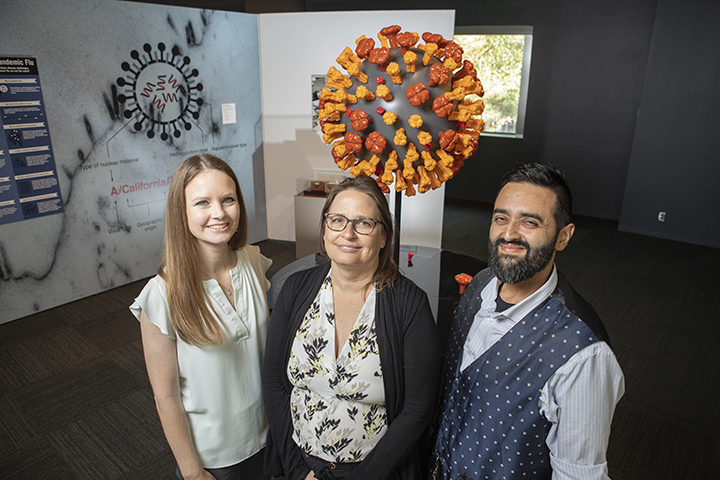Last fall, the University of Georgia and the Georgia Tech Research Institute (GTRI) in partnership with the Georgia Department of Public Health, received $17 million in funding spanning five years from the Centers for Disease Control and Prevention (CDC) to establish a Pathogen Genomics Center of Excellence.
This groundbreaking center, intended to strengthen public health response to infectious disease threats and support public health workforce development, is part of a $90 million investment by the CDC to build a network of centers in five states. Each Pathogen Genomics Center of Excellence (PGCoE) consists of a health department and one or more academic institutions.
Collectively, this work will be focused on transitioning innovations out of academia and into use at public health departments across the United States.
“We really are trying to learn about outbreak epidemiology, those population-scale processes that are impacting disease spread [and] patterns of transmission that are really hard to observe,” said Justin Bahl, an associate professor with joint appointments in UGA’sCollege of Public Health and College of Veterinary Medicine.
Bahl will be leading the project at UGA, focusing on efforts to translate new discoveries into usable data and interventions.
More data, better targeting
Molecular epidemiology uses genomic data to learn how pathogens like the SARS-CoV-2 virus move and infect people within populations. Better understanding the molecular history of a virus can lead to better understanding how it might spread and what populations are most vulnerable, all insights that can greatly aid public health professionals in combating a pandemic or epidemic.
“As a virus evolves, it carries the signal of its past locations and the past species it has infected, and it carries that signal within the genome,” Bahl noted. “By taking an applied evolutionary analysis approach, we’re able to start developing some models that allow us to determine how important those different processes are in the spread.”
Bahl says that adding pathogen genomic data to traditional epidemiological surveillance could dramatically strengthen the public health workforce’s ability to prevent and mitigate local outbreaks.
Making progress in year one
Since the announcement last November, the initial year of work has focused on building the infrastructure and organizing the resources needed to get the project off the ground. Developing an integrated, collaborative network featuring multiple universities and public health labs has taken some time, but it’s also laid the foundation for better data sharing and greater cooperation, says Bahl.
Bahl and his team have begun to review the state of molecular epidemiology in the U.S., assessing the varying needs of different public health labs. The information they collect and share will be beneficial in driving further modernization of data use within public health labs and departments on the ground.
“Can we provide the code to what we’re doing or the data we have access to with, for example, public health departments in the U.S. Virgin Islands or Puerto Rico?” he said. “Can we help them establish their own system, or can we just provide them access to the tools we develop with the Georgia lab so they can try to implement themselves?”
The center is also in the process of building an internship program to engage with students at the College, as well as its other research partners. Bahl said next summer will feature its first class of interns, enabling the students to interact with center researchers and its associated network, ultimately taking their learnings and translating them directly into an applied practical experience at the Georgia Department of Public Health.
Building on a deep foundation
“We have a very strong infectious disease research community here at UGA, especially with pathogen transmission modeling, and a lot of experience with integrating different types of data,” said Bahl. “There are probably not many other places that have the amount of expertise that’s here.”
This work will build on the innovative tools generated from UGA’s interdisciplinary infectious disease research centers, including the Center for Vaccines and Immunology, Center for Influenza Disease Emergence Research, and the Center for Ecology of Infectious Diseases.
“And now we have this center that is focused on taking all this wealth of information that we’ve generated and these new approaches and methodologies, and apply them at the population level, to inform public health response,” said Bahl.
This project, which will establish the Center for Applied Pathogen Epidemiology and Outbreak Response (CAPE), is the fourth major funding investment the university has received in the past 5 years.
Bahl is optimistic that this investment in pathogen genomics will create more pathways for data sharing among scientists and practitioners and enhance genomic surveillance nationwide.
“We’re active, and we’re trying to learn more, translate more to the public health labs and be better prepared collectively to respond to these new threats,” said Bahl. “This investment is about trying to strengthen partnerships with public health. We’re part of that effort, building up public health across the board.”
The team
Team members include Tonia Parrott at the Georgia Department of Public Health; Amy Winter, Erin Lipp, Travis Glenn, Magdy Alabady, Liang Liu, Pej Rohani, Susan Sanchez, Mandev Gill, and John Drake from UGA. They will be joined by Rebecca Hutchins and True Merrill at GTRI. The network across Georgia also includes researchers from Emory University, Georgia State University and Augusta University Medical College of Georgia.
This story was originally published November 17, 2022, at UGA Today.
– Lauren Baggett
Updated December 7, 2023.






